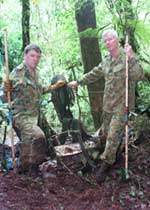|
|
|
| Missing In Action (MIA) | Prisoners Of War (POW) | Unexploded Ordnance (UXO) |
| Chronology | Locations | Aircraft | Ships | Submit Info | How You Can Help | Donate |
|
| RAAF No. 4 Squadron Former Assignments 1 AD 12 RSU  RAAF 1999 |
Pilot F/L Denis Jack Unkles, 408766 (MIA / KIA, BR) Sale, VIC Observer Lt. John Rawden Fetherstonhaugh, VX20171 45 Air Liaison Unit HQ (MIA / KIA, BR) Coleraine, VIC Crashed April 15, 1944 Aircraft History Built by Commonwealth Aircraft Corporation (CAC). Constructors Number 681. On December 20, 1941 assigned to the Royal Australian Air Force (RAAF) as CA-9 Wirraway serial number A20-480. That same day, assigned to 1 Air Depot (1 AD). On December 24, 1941 a presentation plaque "Spirit of Illawarra" was attached to the aircraft in honor of the Illawarra region of New South Wales in Australia. Wartime History On March 5, 1942 took off piloted by P/O R. H. Drabsch on a flight and the engine was running slow due to a flooded carburetor. After landing at Fairbairn Airfield (Canberra Airport) the exhaust ignited the excess fuel, causing a fire that damaged the starboard fabric panel and burned the forearm of observer Sgt B. H. Smith, 8603. Afterwards, repaired by 1 AD. Assigned to 12 Repair Salvage Unit (12 RSU) then No. 4 Squadron operating from Gusap Airfield. Assigned code QE-V. No known nickname or nose art. On February 26, 1944 pilot F/O J. Ahern, 426817 was taxing in the dispersal area at Gusap Airfield and hit a fuel dolly that damaged the air screw. Afterwards, repaired and returned to service. Mission History On April 15, 1944 at 7:55am took off from Gusap Airfield piloted by F/L Denis Jack Unkles with observer Lt. John R. Fetherstonhaugh from the 45 Air Liaison Unit, Australian Headquarters, AIF on a tactical reconnaissance mission over Japanese occupied areas near Wantoat. After takeoff, the plane was never seen again and declared Missing In Action (MIA). In fact, this Wirraway crashed into in a hillside near Kewieng village in the Finisterre Range. Afterwards, villagers trekked to the crash site and buried the remains of the crew next to the crashed plane. Wreckage During 1998, American anthropologist Dr. Will Betz was told about aircraft wreckage at an elevation of 7,546' / 2,300m near Kewieng village in the Finisterre Range. Later, the crash site was visited by Richard Leahy and Dr. Will Betz and identified as Wirraway A20-480. anthropologist Recovery of Remains During 1988, villagers claimed the crashed plane was "perused by a Japanese fighter causing it to crash". Afterwards, the villagers buried both bodies at the crash site. At the time, one villager who was a boy at the time was an eyewitness to the burial. In October 1998, a RAAF Forensic Recovery Team "Operation Kewieng" visited the crash site and conducted a survey and excavation that resulted in the recovery of both crew members. Memorials Both were officially declared dead the day of the mission. After the recovery of remains, both crew members were buried with full military honors at Lae War Cemetery on January 13, 1999. Unkles at NN. C. 13. Fetherstonhaugh at NN. C. 12. References ADF Serials - Wirraway A20-480 ADF Health "Recovery of Australian service personnel missing in action from World War II' (April 2000) pp 51-52 "Dr Betz, an American anthropologist, was informed of a crashed aircraft by Papua New Guineans from the village of Kewieng, about 90km north-west of Lae at about 2300m elevation in the Finisterre Range. An expatriate Australian, Mr Richard Leahy, attended the site with Dr Betz, and identified the aircraft as an RAAF Wirraway A20-480. According to villagers, the two occupants of the aircraft had been removed from the wreckage, and buried beside the aircraft shortly after the crash. In October 1998, the Forensic Recovery Team was flown to a base camp which had been constructed with the assistance of Kewieng villagers. The crash site was surveyed and a 1,520m grid was plotted. Although a landowner had been present at the burial of the aircraft occupants, and claimed to know the exact location of the graves, comprehensive excavation of this grid square down to 1.8 m failed to locate any human remains. At this level, a further layer of topsoil was found and it was concluded that a landslide had occurred some time after the crash, and that the aircraft had probably slipped down the mountainside. Further deep excavation higher up the mountain revealed fragments of canopy perspex and aircraft wreckage at a level of 1.8m. Fragments of human remains were eventually located below this level and under the aircraft. The remains of the aircraft pilot and observer were positively identified from their antemortem dental records. The remains were buried at the Commonwealth War Cemetery in Lae in the presence of relatives." CWGC - Denis Jack Unkles FindAGrave - Flight Lieutenant ( Pilot ) Denis Jack Unkles (grave photo) CWGC - John Rawden Fetherstonhaugh FindAGrave - Lieutenant John Rawden Fetherstonhaugh (photo, grave photo) Thanks to Dr. Will Betz and Richard Leahy for additional information Contribute Information Are you a relative or associated with any person mentioned? Do you have photos or additional information to add? Last Updated January 12, 2024 |
Wirraway MIA 2 Missing Resolved |
| Discussion Forum | Daily Updates | Reviews | Museums | Interviews & Oral Histories |
|